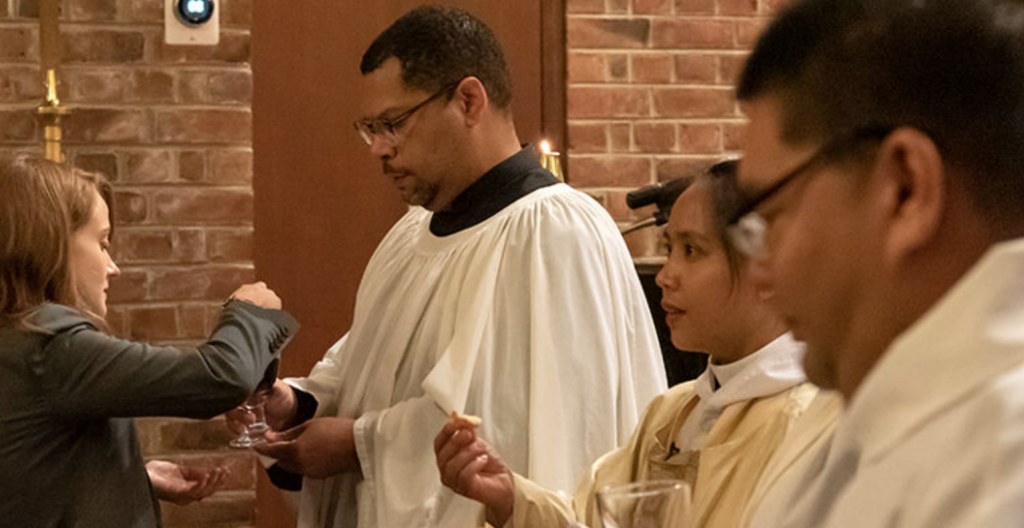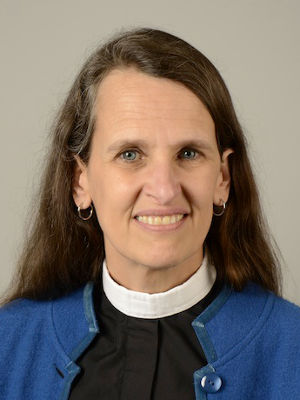Spiritual Communion in a Season of Social Distancing


By the Rev. Ruth A. Meyers, PhD
In this time of social distancing, when we cannot come together to celebrate the eucharist, church leaders are introducing creative responses such as packing plastic bags with consecrated wafers for people to drive up and take home, or suggestions that people in disparate places provide their own bread and wine as a presider in another space prays a eucharistic prayer. Such efforts suggest hunger for the body and blood of Christ.
The desire to receive communion reflects a sea change in eucharistic piety in the Episcopal Church during the late twentieth century. The liturgical renewal movement was highly effective in transforming the Episcopal Church, fostering a eucharistic spirituality with an expectation that the Holy Eucharist is the principal act of worship on the Lord’s Day (BCP 13). We’ve come a long way from the common practice of monthly celebrations of Holy Communion or the non-communicating high mass of some Anglo-Catholic congregations.
Yet the efforts to provide consecrated eucharistic elements suggests to me that the liturgical renewal movement did not fully transform our eucharistic theology. The urgency for people to receive communion and efforts to stretch our practices to allow that to happen are a curious twist on medieval eucharistic theology and practice.
In the medieval western church, a practice of “ocular communion” was the most common experience of the mass. Christians came to understand the words of institution over the bread and the cup as consecrating the bread and wine, changing them into the body and blood of Christ at that precise point in the prayer.
Sanctus bells signaled the arrival of this moment of consecration, and after reciting Jesus’s words, the priest elevated the host. People jostled for the best place to view this miracle. But receiving communion was so infrequent that a thirteenth-century church council required everyone to receive communion once a year, at Easter, a sure sign that few people were partaking even that frequently.
Just as the practice of ocular communion emphasized the consecration to the near exclusion of the reception of the elements, proposals to bend the rules to allow people to receive focus on one moment rather than the totality of the celebration. Since the earliest centuries of Christianity, eucharist has included both a prayer of thanksgiving in which the assembly remembers what God has done for us and the sharing of the eucharistic gifts of bread and wine, Christ’s body and blood.
One proposal to hold these together is for a presider in one place to pray the great prayer of thanksgiving while those sheltering in their homes have their own bread and wine to be consecrated. Yet this practice places undue emphasis on the reception of communion. Sharing one bread and one cup is integral to communion, as the apostle Paul reminded the Corinthians: “Because there is one bread, we who are many are one body, for we all partake of the one bread” (1 Corinthians 10:17). A webcast or Facebook livestream or Zoom meeting can help us feel connected to our community, but it does not allow us to share one bread or one cup.
In the celebration of the eucharist, we experience the real presence of Christ, not only in the bread and wine that are blessed and shared but also in the Word proclaimed and broken open in homily, in the community gathered as the body of Christ, in song and prayer. This real presence is always in tension with real absence. We glimpse Christ’s presence, getting a taste of the heavenly banquet, yet on this side of the grave we never experience the fullness of that presence. Real absence draws us forward to the time when we shall see God face to face. Real absence makes room for the mystery of God whose presence we can neither compel nor control.
Social distancing makes us keenly aware of real absence and our yearning for the real presence of Christ, an experience we share with Christians through the ages. To respond when we cannot celebrate eucharist, Christian tradition offers us the practice of spiritual communion. St. Thomas Aquinas explains this as “an ardent desire to receive Jesus in the most holy sacrament and lovingly embrace him” at times when it is not possible to receive the sacramental elements.
The 1979 Prayer Book refers to spiritual communion in the form for Ministration to the Sick, directing the priest to assure a person unable to eat and drink the bread and wine “that all the benefits of Communion are received even though the Sacrament is not received with the mouth” (BCP 457). The Prayer Book for the Armed Services suggests a prayer for spiritual communion:
In union, O Lord, with your faithful people at every altar of your Church, where the Holy Eucharist is now being celebrated, I desire to offer to you praise and thanksgiving. I remember your death, Lord Christ; I proclaim your resurrection; I await your coming in glory. Since I cannot receive you today in the Sacrament of your Body and Blood, I beseech you to come spiritually into my heart. Cleanse and strengthen me with your grace, Lord Jesus, and let me never be separated from you. May I live in you, and you in me, in this life and in the life to come. Amen.
In this season of social distancing, individuals and congregations can practice spiritual communion in a number of ways. Any Christian desiring to receive the sacrament can offer a prayer for their own spiritual communion. Some congregations have the resources to gather a small number of leaders for a full celebration of communion, inviting others to view the celebration from their homes and feed on Christ in their hearts by faith, with thanksgiving (BCP 365). Other congregations may find that their resources enable them to offer the liturgy of the Word via livestream or video conference, and adapt that form to include prayers for spiritual communion.
The apostle Paul assures us that nothing will be able to separate us from the love of God in Christ Jesus (Romans 8:39). Spiritual communion offers one way to sustain ourselves as we await the time when we can once again gather in the same space with other Christians to celebrate eucharist.
Ruth Meyers is dean of academic affairs and Hodges-Haynes Professor of Liturgics at Church Divinity School of the Pacific.

